Joint action with the guerrillas of the Consolidated Detachment in the enemy rear
Developing an offensive in Polesie, the troops of the 65 Army in December 1943 of the year came to the Parichs, deeply wedged into enemy territory. The enemy entrenched here in the settlements and created a focal defense. Between the cities of Parichi and Ozarichi there were several large gaps in the line of enemy defense, which were widely used by the Belarusian partisans for communication with the units of the Red Army, and the troops - for sending reconnaissance and sabotage groups into enemy rears.
In order to unite the groupings of their troops leading the defense in the Ozarichi and Parichi area, to create here a continuous front line and close the "partisan gates", the German command of the forces of the grouping of forces consisting of three infantry and two tank divisions, urgently transferred from Bobruisk and from other directions, struck a counterattack on the right flank of the 20th Army on December 65. The situation on this sector of the front, where there were only two rifle divisions (37th Guards and 60th), was very difficult. The Nazis were able to break through the defense line of the 60th Infantry Division, push our troops back 25-30 km and close the "partisan gates".
In the enemy rear, among other scattered divisions, the 1 battalion of the 1281 rifle regiment of the 60 rifle division also appeared. Together with the battalion, Colonel N.I., deputy regiment commander for political affairs, also found himself in the German rear. Frenkel. As he failed to break through to the units of the division, he, as a senior officer by rank and rank, decided to withdraw the battalion and other divisions located near the division to the area controlled by the Poles'e guerrillas - to the village of Zaozerie. Here, a part of the 60 and 37 divisions joined the battalion; they were also cut off from their units or performing combat missions in the German rear.
Without losing time, Colonel Frenkel immediately established contact with the commander of the partisan brigade, F.I. Pavlovsky, whose headquarters were located in Karpilovka, and then with the commander of the Polesia guerrilla unit I.D. Windshield. The meeting commanders occurred in the village of Buda. It was decided to create a Consolidated detachment of soldiers of the 65-th army, who were in the German rear, and to act with his forces together with the partisan formations. This decision was reported on the radio of the partisan unit to the military council of the 65 Army. At the same time, the leadership of the partisan unit issued a resolution on assisting the regiment with food and ammunition.
December 24 Col. N.I. Frenkel, having received powers from the military council of the army, issued an order, which, through the commanders of partisan detachments, was transferred to all servicemen of the 65 Army who were in the rear of the German troops in the area of operations of the partisans of the Polesia and Minsk regions. It stated that military personnel must arrive in the village of Karpilovka by December 29, having with them the rest of their own and received from the partisans weapon, machine guns, ammunition, communications equipment, as well as horses, carts and other military equipment with which they ended up in the partisan zone. In total, 47 officers and more than four hundred fighters from various units of the army gathered in Karpilovka. In addition, the command of the partisan detachment handed over to the commander of the 147 regiment the unarmed partisans, as well as the 29 Slovak soldiers, who went to the partisans in order to continue to fight in the Czechoslovak brigade L. Svoboda.
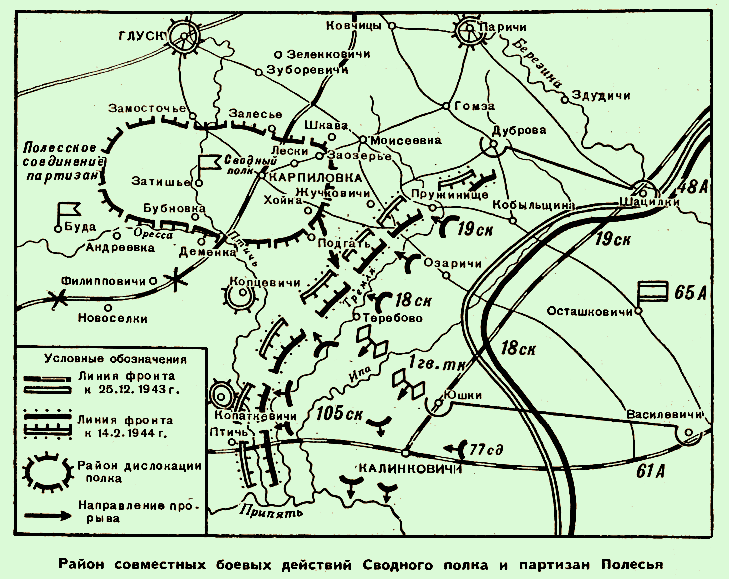
The military council of the 65 Army appointed Colonel N.I. as commander of the regiment. Frenkel, his deputy for the political part of Major B.М. Chertok, and administratively - Major A.I. Yagupova.
The combined detachment was formed within a few days as part of the 2-x battalions (commanders of senior lieutenants F.A. Losev and FM Grinchuk), reconnaissance (commander lieutenant V.I. Mayboroda) and engineer (commander lieutenant NM Zass) company and service units.
Using the help of the Poles partisans and local residents, the rear units of the regiment prepared grain, meat, vegetables and salt. A bakery was built on its own, cooking boilers were made. Much attention was paid to the issues of engineering equipment of the area of location and increasing the readiness of personnel to repel a surprise attack by the enemy. In the villages of Zaozerye, Zatishye, Bubnovka, and Leskaya, company headquarters were equipped with bunkers and dugouts, main and reserve positions for mortars and heavy machine guns, trenches and communications were dug. On the main roads leading to Zaozerye, anti-tank debris has been built. Gradually, the personnel of the regiment equipped two battalion defense units in Lull and Bubnovka. The unarmed partisans who were part of the demining company were engaged in engineering and food preparation. Thus, in a short time, the regiment created a solid defensive position in one of the main areas of the partisan zone. It served as a base for the training of subunit personnel for combat operations, raids on fascist garrisons, sabotage, and search for intelligence officers.
In some cases, taking advantage of the lull, the command with the aim of putting together units carried out combat and tactical exercises. The personnel trained tactics of partisan detachments, forms and methods of combat operations in the rear of the enemy. Widely carried out intelligence. She was led by horse and foot scouts, which led the chief of staff of the regiment of art. Lieutenant N.F. Gormin and Chief of Intelligence Lieutenant I.F. Yurasov (from the partisans). Intelligence activities mainly consisted in organizing systematic daily monitoring of the Germans in the area of Shkava, Moiseyevka, Podgat, Koptsevichi. On all roads and in settlements, the headquarters set up intelligence posts. Subversive actions were carried out at the initiative of the regimental command. They must have been coordinated with the command of the partisan brigades of F.I. Pavlovsky, V.3. Putiato et al., As well as the Polesye Partisan Connection. Combat operations were planned in close cooperation with partisan detachments stationed near the regiment's location. All this was done in accordance with the orders of the 65 Army Headquarters, the essence of which was that the regiment acted on its own initiative and waited for the approach of the army troops.
The extracted reconnaissance communications were daily transmitted to the headquarters of the Polesye Partisan Connection, and from there they were reported by radio to the headquarters of the 65 Army and the Belorussian Front. In particular, reconnaissance groups of lieutenants V.I. Mayboroda and V.S. Miroshnikova regularly infiltrated enemy positions and collected vital information about the enemy and his intentions. Active and sabotage groups. So, in one week from 29 December 1943, they destroyed and undermined enemy trucks on 12 mines, killed and wounded enemy soldiers and officers before 40, dismantled and undermined 4 bridge.
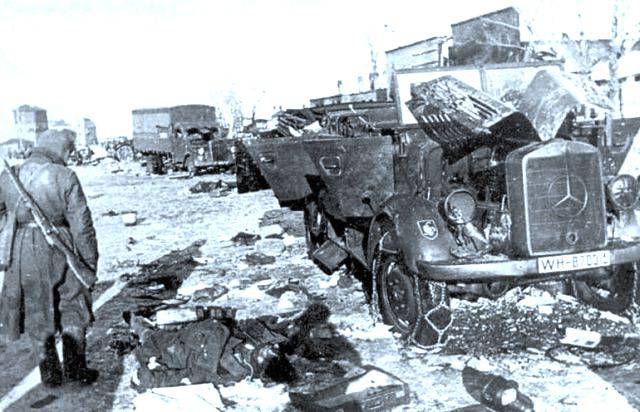
During this period, the troops of the 65 Army, stopping the enemy and starting to restore the situation on the right flank, launched an offensive against Kalinkovichi. At dawn on January 14, after two days of fierce fighting, the formations of the 65 and 61 armies, supported by the cavalry corps of generals V.V. Kryukov and MP Konstantinov, as well as tank units of General MF. Panov and the Polissya partisans defeated the large German forces under Mozyr and Kalinkovichi and took control of these important points.
Acting in the rear of the enemy, the Combined squad provided all possible assistance to the 65 Army. Thus, from January 5 to February 14, 1944 of the year, his units, in cooperation with the partisans of the Polesye Connection, conducted several successful battles against the garrisons, punitive, guard and rear units of the enemy. The first battle (conducted by the 1 Battalion) was of the nature of a night raid on a fascist garrison located in the village of Koptsevichi. It was also attended by two partisan detachments under the command of F.G. Ukhnaleva and G.N. Vasiliev, and other units. The plan was developed by the headquarters of the Polesia guerrilla unit with the participation of the regimental command and partisan detachments. In preparing the attack, the command brought the task to each performer, taking into account the information about the number of the garrison, the most advantageous approaches to the settlement and the system of fire. The battalion and guerrilla raid began simultaneously on a common signal (red rocket) on the night of January 9. Carefully prepared attack was so sudden that the Nazis did not have time to make a single shot. The attackers broke into the village from all sides and threw grenades at the hut where the Germans were stationed. As a result, the enemy garrison was defeated, destroyed around 200 fascists. The success of the battle in Koptsevichi was largely due to the raid of the partisan brigade A.F. Zhigarya on enemy garrisons in the neighboring villages Filippovichi and Novoselki.
The fighting of the regular part of the Red Army in the German rear caused an exaggerated idea of the size and combat capability of the Combined Regiment among the fascist command. Thus, a rumor quickly spread among the enemy’s troops that, together with the partisans, there was a special guards division, specially sent to the rear. After the defeat of the garrison in Koptsevichi, the Nazis significantly increased the number of troops in the settlements adjacent to the partisan zone of the Polesye region, reinforced them with tanks, artillery and armored vehicles.
It is characteristic that in the battles conducted by the Consolidated Regiment, the Red Army tactical methods and guerrilla warfare methods were widely combined. The combat order of subunits usually included the following groups: intelligence, cover, shock. The decision also determined the positions of the fire weapons, the places of the command post and the rear areas. The connection was maintained by coherent (foot and horse messengers), as well as with the help of pre-established observation posts. The fighters attacked the enemy suddenly, where he least expected. Having a good possession of personal weapons, they fired only aimed fire, firing points of firing points, which prevented advancement, with grenades. During the battle, the fighters and partisans worked closely, always came to the aid of each other.
In mid-January, when units of the 65 Army launched an offensive against Ozarichi, the Combined Detachment conducted several successful battles against enemy garrisons in the Demenka, Polgat area. However, his position was becoming increasingly difficult, as there was a lack of ammunition. The command of the Polesia guerrilla unit itself felt a need for them and could not provide assistance. So, in the performance release number 7 from 25 in January 1944, the commander of the compound I.D. Vetrov reported to the Belarusian headquarters of the partisan movement: “Under the protection of the brigades of the Polesye Connection there are up to 70 thousand people. For more than a month, brigades have been fighting with large enemy forces. Ammunition left 3-5 per rifle, one drive per machine gun. There is no explosive. ”
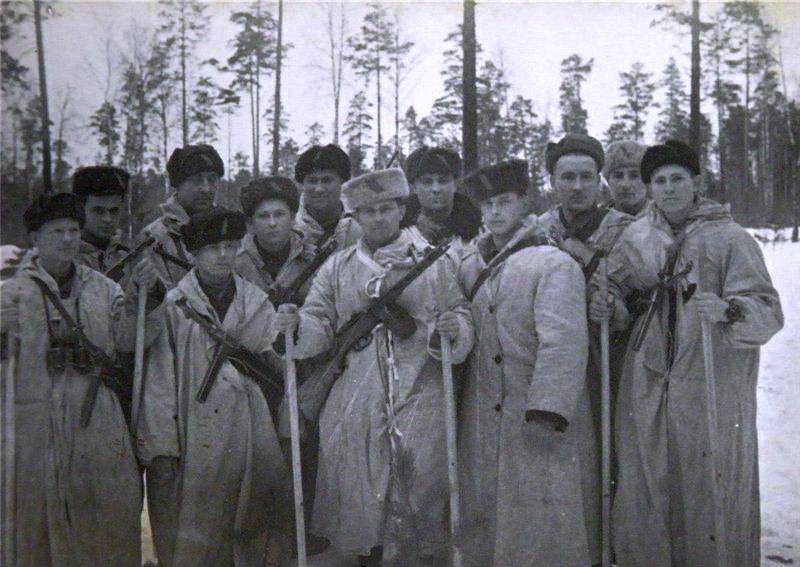
Despite the difficulties, the regiment continuously conducted active hostilities. 7 February the regimental headquarters learned that a group of adversaries numbering up to 120 had laid a five-wire four-core cable from Karpilovka station (by that time it was already in the hands of the fascists) in the direction of Demenki. Urgently developed a plan of operation. The task of defeating the fascists received the two best companies of both battalions.
In the oral order of art. Lieutenant F.A. Losev set the following tasks for the company’s personnel. The first company was to operate from the village of Zatishye, bypassing the group on the left, and the second - bypassing the right, from Bubnovka. According to the general signal, the companies should strike in opposite directions and surround the enemy. As a result of the fleeting battle, the companies dispersed the enemy group, seized the wire and cut it into pieces. The Nazis did not manage to build a communication line between settlements, while the Combined squad was operating in the area. The 9 and 10 February companies of the first battalion, operating in the area of Moiseevka, Zhuchkovichi, Leski, fought three times a day with enemy units heading for the leading edge, and companies of the second battalion violated on the railway the movement of enemy echelons, and on the highway - columns of troops.
In February, the regiment continued to conduct reconnaissance and sabotage work. During this time, his personnel lined up and blew up a 2 medium tank mines, 4 trucks and 2 cars and several carriages. At the same time, more than 30 of enemy soldiers were exterminated, 3 of the “language” was captured, including one officer. The important information received from him was transferred by the command of the Polesia guerrilla unit to the headquarters of the 65 Army and the Belorussian Front. For two months of being in the enemy's rear, the Combined Squad conducted 16 battles, destroyed the 4 bridge, hit the 2 tank, blew up enemy vehicles on the 18 mines, destroyed about 300 fascists.
In early February, 1944, the troops of the 65 Army, meeting stubborn resistance, lowered the speed of the offensive, but continued to slowly move forward. With heavy fighting forced the river Tremlyu. The Germans at that time undertook a punitive operation directed against the partisans of Polesye who prevented them from building defensive lines west of the Ptich River and concentrating their reserves here. In this situation, the command of the Consolidated Regiment decided to break through to its troops. Having permission to break through from the command of the 65 Army, the headquarters began to energetically prepare for the operation.
On the morning of February 12, a plan was adopted to break through the enemy battle formations of the Zhuchkovichi, Hojna, Podgat section in the direction of Terebovo, where the terrain most of all contributed to passing through the enemy defenses. Columns (the regiment was advanced by five routes) were headed by Colonel N.I. Frenkel, Art. Lt. F. Losev, N.F. Gormin, F.M. Grinchuk, Lieutenant V.I. Mayboroda. Ahead of the main forces along each route were reconnaissance groups headed by column commanders. An 2-3 guide from local residents and partisans who knew the terrain and routes went with each group.
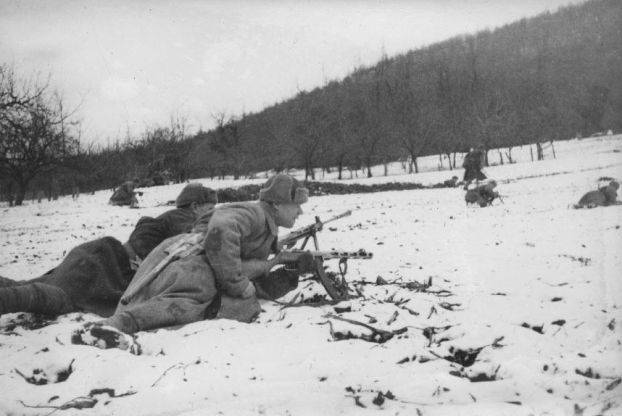
The regiment met stubborn resistance of the enemy on the approaches to the village of Terebovo. As a result of the fierce battle, the Nazis suffered significant damage in manpower and equipment, the main forces of the regiment consisting of more than one hundred and fifty fighters and 16 officers led by the regiment commander broke through February 14 across the front line. Great assistance to the regiment in the breakthrough had a ski battalion, specially allocated for this purpose by the command of the army. Having joined their units, soldiers, sergeants, officers continued to fight on the fronts of the Great Patriotic War. But not everyone managed to break through the front line. Part of the fighters and officers was forced to once again withdraw to the rear of the German troops, and here she continued to fight in partisan detachments.
As we can see, despite the extremely difficult situation in which part of the 60 units and the 37 units of the Guards Rifle Divisions found themselves in the German rear, they were immediately united by a single command, put together and trained for action with the partisans. In close cooperation with the partisan detachments, the Consolidated Regiment inflicted significant damage to the enemy, and then organized, by order, broke through the main forces through the German military formations and went to the Soviet troops. This is strikingly different from the situation in the initial period of the war, when the surrounded Soviet units, lacking communication, were fragmented, and, despite heroism, could not in most cases conduct organized actions in the enemy’s rear. The environment no longer frightened Soviet soldiers and officers, they skillfully used their position, trying to inflict maximum damage on the enemy.
Sources:
Batov I. In campaigns and battles. M.: Military Publishing, 1974, p. 389-394.
Chertok B. Actions of the 65 Army Combined Regiment in the rear of the enemy. // visage 1975. No.9. C.37-42
Miroshnikov B. Partisans, Belarusian sons ... // Sovetskaya Belorussia. 5 November 2008.
Faberov E. Commissioners. // Bulletin. 1999. No.6 (213). C.34-37.
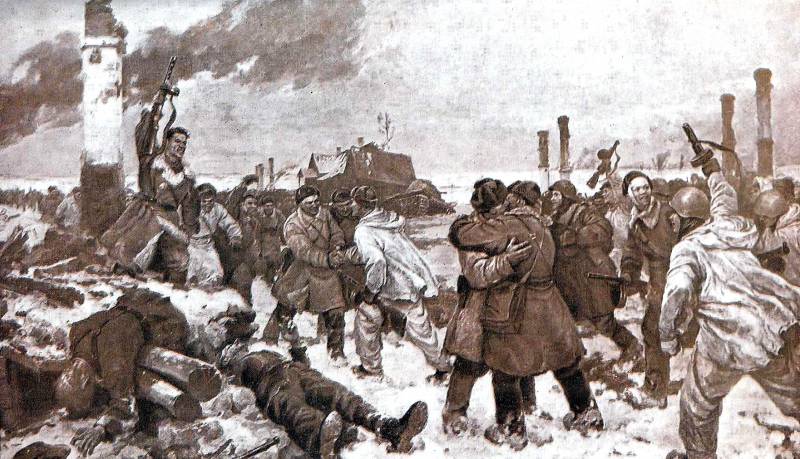
Information